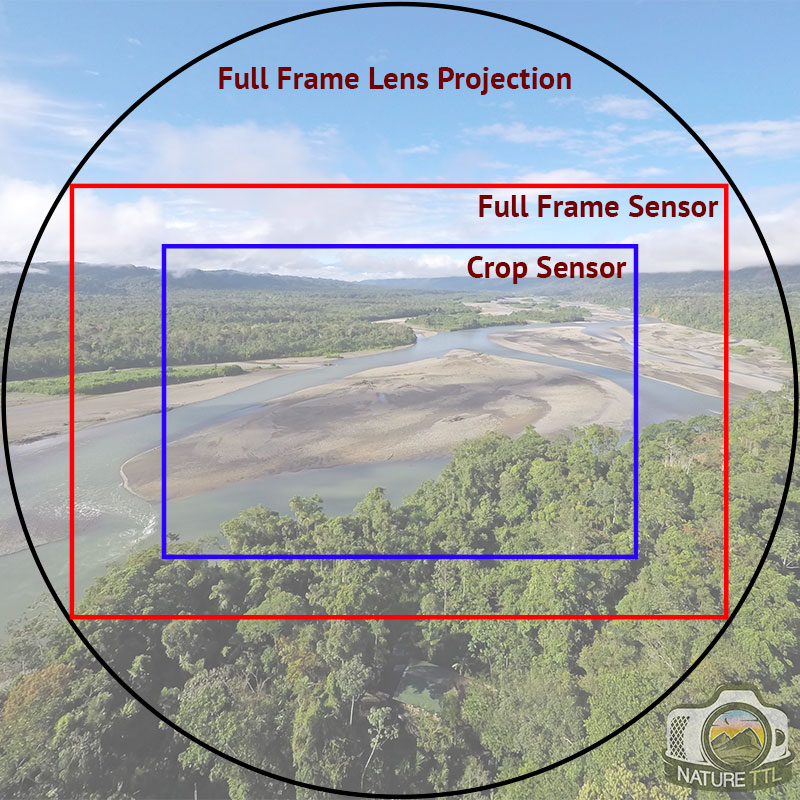The Difference Between Full Frame & Crop Sensors

If you’ve ever picked up a camera, you will have heard the terms full frame sensor and crop sensor. Originally, film cameras shot on a 35mm film reel. When digital SLRs came about, manufacturers made large 35mm sensors so that people could transition easily and continue using their ‘film’ lenses on the new cameras. These are known as full frame sensors.
But this technology was expensive and so smaller, cheaper sensors were produced: the crop sensors. These sensors would work with the older full frame lenses too, but they also produced cheaper lenses to go along with them. These cheaper ‘crop sensor’ lenses mimic the original focal length you would expect on a full frame camera.


What is a Crop Factor?
Lenses are circular by nature and produce a circular projection (the field of view). What is recorded by a full frame sensor is actually a rectangular crop of this, and is used as a baseline. Using a full frame lens on a camera with a crop sensor will result in a cropped field of view. You can see this in the diagram below.
The extent of this crop is known as the ‘crop factor’, and this varies between different manufacturers. For Nikon cameras, this is a 1.5x crop. For Canon 1D users, this crop is 1.3x. Other consumer Canon cameras have a 1.6x crop. This table looks at the increased reach each crop factor brings about for different lenses:
Lenses
There are both full frame and crop lenses on the market. The latter are cheaper and of a lower quality, affecting everything from sharpness to maximum aperture. Full frame lenses are much more expensive, often going into the thousands, but they are professional grade and tend to be extremely sharp with better maximum apertures.
Manufacturers use the following acronyms in the full name of a lens to determine if it is made for crop sensor cameras:
- Canon — EF-S
- Nikon — DX
- Sony — DT
- Pentax — DA
- Sigma — DC
- Tamron — Di-II
For full frame lenses, Nikon call these FX and Canon call them EF.
Choosing Between Full Frame and Crop Sensors
Advantages of crop sensors. Being able to take advantage of the crop factor increases the reach of your lens. This is great news for wildlife photographers especially, meaning it’s easier to take frame-filling shots of animals. Those using full frame cameras have to get closer, or pay for even longer lenses.
Advantages of full frame sensors. Full frame sensors don’t have as much reach, but they perform much better at high ISO speeds – this is great for shooting in low light. You’ll see better image quality with regards to dynamic range too, recording more detail in the whites and blacks of your photo. Full frame cameras are expensive for a reason – if you want maximum image quality, then this is the choice for you.
Cost is a big issue. Full frame cameras are definitely expensive. You’ll find yourself paying thousands for a full frame camera. There’s no getting around that fact, and this is something you should think seriously about. If you love photography and it makes up a big part of your life, then that probably justifies going full frame. But if your camera is going to sit gathering dust then it’s probably better to start out with a crop sensor.
Keep in mind the lenses too. If you’re going to be buying lenses made for crop sensors, then they won’t work on full frame cameras should you later upgrade. This is a potential cost to you in the long term. Plus, if you want to benefit from the crop factor you still need to buy the expensive full frame lenses. Crop sensor lenses lack sharpness and quality in comparison to professional lenses and there will definitely come a time you want to upgrade.







